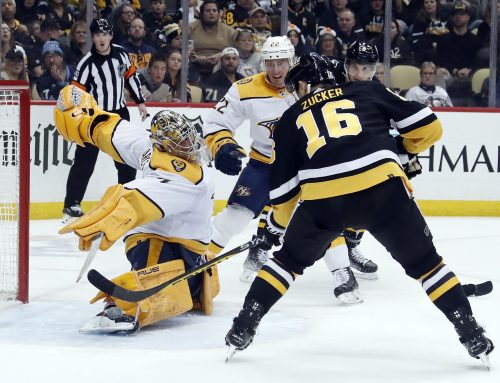
Today we cover some recent contract signings and each player’s impact in both points-only and rotisserie scoring formats.
As an offseason of weirdness wraps up and a new season begins, there are still signings taking place in the NHL that have an impact on the fantasy hockey world. With so few cap dollars remaining it was difficult for the remaining free agents to find an ideal home. As a result, the majority of them have to sign for less than they would have during a typical summer where the cap ceiling rises instead of dropping. This is to the benefit of fantasy owners in cap leagues.
Damien Brunner (New Jersey)
2013-14: 2,500,000
2014-15: 2,500,000
Damien Brunner arrived on the scene last year and delivered as advertised in Detroit. As an unrestricted free agent he was not quick to strike a deal and may have lost out on some money. Bad for him, good for fantasy owners.
In points-only leagues Brunner’s new contract with a cap hit of $2.5 million, which is close to the league average, should be seen as a good bargain. Not only does he have a good track record putting up points in the NHL and overseas, but he also walks into a good spot in New Jersey to be relied on as one of the go-to guys up front. He should be a fixture in the top-six and on the power play.
In rotisserie leagues it is a different story. Aside from goals, assists, power play points and shots on goal Brunner is a poor multi-category contributor. He offers no grit and does not block shots. Given the abundance of cheap all-around forward contributors available, you can probably find a better alternative for the price.
Mason Raymond (Toronto)
2013-14: 1,000,000
Mason Raymond has had a strong training camp and preseason, which earned him a new contract with the Toronto Maple Leafs. The cost of just $1 million is noteworthy for a player with this much speed and talent. However, he does not possess as much offensive upside as Brunner which makes him a marginal fantasy asset.
Raymond once posted a 53-point season but has not been the same player since suffering a fractured vertebrae back in 2011. The last two seasons he has been pretty ineffective offensively which led to Raymond's troubles finding work this summer.
In Toronto, Raymond once again has an opportunity to become a solid depth scorer. Helping matters are injury-prone Joffrey Lupul and now-suspended David Clarkson ahead of him on the depth chart. There might be enough opportunity for Raymond to become a valuable depth option in deep points-only leagues.
However, much like Brunner, Raymond is not a very good rotisserie player. In addition to decent totals in goals and assists he also shoots the puck frequently. Beyond that it gets thin. Raymond is not a factor in hits, PIM or blocked shots and only has 13 total power play points over the last three years.
In Raymond’s price range you can find many of the league’s elite producers in the physical categories both up front and on defense. In most situations you will be better served using cheap gritty players to do the heavy-lifting in your peripheral categories while spending the big money on top offensive players. In the deepest of leagues Raymond could still hold some value though.
Brenden Morrow (St. Louis)
2013-14: 1,500,000
Brenden Morrow has been showing signs of decline over the last couple years. Last season he showed he still has some gas left in the tank. In 44 games split between Dallas and Pittsburgh he had 25 points, 37 PIM, 85 his, 20 blocked shots and 55 shots on goal.
Morrow signed a cheap $1.5-million contract with St. Louis, a team that is deep up front, and will likely play a bottom-six role. In points-only leagues Morrow should probably be forgotten at this point. While his offensive numbers last year were solid, he is clearly in decline so it would be foolish to depend on continued production. Morrow will likely be a depth role-player who can occasionally rise to a scoring line in the event of an injury moving forward.
Morrow’s value lies in rotisserie leagues. While he is no longer the same player in any category, his new contract makes him an interesting cap bargain. His offensive production will be mediocre but if you combine that with good totals in hits, PIM and blocked shots you have a pretty balanced rotisserie player.
Matt Read (Philadelphia)
2013-14: 900,000
2014-15: 3,625,000
2015-16: 3,625,000
2016-17: 3,625,000
2017-18: 3,625,000
Matt Read has emerged as a strong all-around forward in his two NHL seasons. He has been rewarded with a lucrative four-year contract extension. While the contract is justified based on his real-life value, in some fantasy hockey settings it may prove to be too rich.
For starters, since Read’s new contract is not in effect this year, he is one of the best cap bargains in any one-year formats. Both of his NHL campaigns saw him produce at a pace that would put him just short of the 50-point mark which is solid considering the low cost. Additionally, he has provided an effective combination of hits, blocked shots, special-teams points and shots on goal.
In keeper leagues Read becomes more of a muddy case after this year. His scoring at the NHL level has been impressive but the overall sample size (121 career games) is small and he was not an elite point producer prior to turning pro. It is not clear if he will be able to exceed his current production level. It is very possible that he will but at $3.6 million he carries more risk.
In rotisserie leagues Read should still be a solid player to own moving forward. Aside from his non-existent PIM totals he should produce at an average or above-average level in every category which makes him a well-balanced player. Read will no longer be considered a bargain player but will not be overpaid by any means.
Previously in Capped:





 CAR
CAR FLA
FLA BUF
BUF EDM
EDM DAL
DAL ANA
ANA UTA
UTA MTL
MTL
